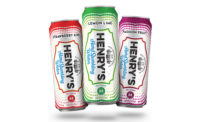PREDICTIONS 2025
What’s Next in Beer, Wine, and Spirits? Key Trends Redefining the Alcoholic Beverage Landscape for 2025
Datassential identifies top alcoholic beverage trends impacting the category in the coming year

Tamarind—On Trend! To celebrate National Vodka Day (October 4), Diageo North America’s Smirnoff Spicy Tamarind partnered with leading on-demand beauty service Glamsquad, on a campaign promoting the product’s fusion of sweet and spicy flavors as well as the big and small occasions in Hispanic culture.
PHOTO CREDIT: PRNewsfoto/SMIRNOFF/Diageo North America

Venue-Specific Appeal! Princess Cruises addresses consumer interests in clean, reduced alcohol alternatives. Princess bolstered its "Love Line Premium Liquors” collection of wine and spirits with new Betty Booze and Betty Buzz offerings from actor and entrepreneur Blake Lively.
PHOTO CREDIT: PRNewsfoto/Princess Cruises

Beer—with Benefits. More beers taking health-minded approach. Holidaily Brewing, Golden, Colo., launched a crowdfunding campaign to expand its namesake line of gluten-free beers. Holidaily uses gluten-free grains such as buckwheat and millet to brew beers safe for those with the highest gluten sensitivities.
PHOTO CREDIT: Holidaily Brewing Company



Datassential released its Future of Drink report and unveiled the top alcoholic beverage trends across beer, wine, and spirits for 2025 and beyond.
"This year's Future of Drink report reveals how rapidly shifting consumer desires and habits are shaping a new wave in alcoholic beverages," said Ann Golladay, senior director, publications, at Datassential. "From bold new flavors to the latest in tech and sustainability, our findings help industry leaders navigate the evolving landscape with confidence."
The annual report provides key consumer insights across 134 trends in the alcoholic beverage industry, spanning beer, cider, wine, cocktails, seltzer, and spirits. It highlights "10 Mega Trends to Know," including alcohol-free options, global flavor influences, health-driven "better-for-you" beverages, emerging sensory experiences, and sustainability's growing impact on producers.
Additionally, the report identifies eight mini-trends, offering a comprehensive view of both major and emerging movements shaping the future of the beverage market.
Here's a look at some emerging trends covered in the report:
Botanical and Savory Swigs: Botanical and savory flavors are making their presence known more than ever before in beverages, with options from mead (made with fermented honey) and vermouth (made with aromatic herbs) being seen more on menus, as well as options like gin-based or pickle seltzers, flower wine and pastry stouts, and even vegan fat-washing.
Elevated Staples: No longer contained to college frat parties, shots have undergone a makeover and are now appearing alongside sophisticated spirits. Highbrow gelatin shots are being made with classic gelatin but infused with premium spirits, bitters and fresh juices, creating the perfect cocktail in a single bite. And craft/signature shots are evolving into well-rounded concoctions, consumed in one gulp or savored as a mini cocktail.
The Global Wave: Global flavors have significantly influenced the food and beverage industry in recent years, and this year's report features the newest entries into adult beverages, including ube cream liqueur and the addition of tamarind in cocktails.
Venue-Specific Consumer Profiles: Did you know that Eatertainment venue visitors are most interested in trying hard sodas, while hotel/resort guests are seeking dessert wines and cocktails on tap? The report breaks down customer profiles at 20 different venue types, including a breakdown by gender, income, generation, lifestyle habits, drinking preferences, and interests.
"Consumers, especially younger ones like Gen Z, are showing a strong interest in category disruptors like fruit-based wine, wine cocktails, flavored wines, and beverages with a cause or sustainable message," said Datassential's Chief Customer Officer and Sommelier DipWSET Colleen McClellan. "It's exciting to see how brands will meet consumers where they are, offering more unique options within the traditional beer and wine categories—much like how the spirits market has evolved with RTDs (ready-to-drink), functional ingredients, and global influences."
Ten New Trends
Datassential also broke out 10 new trends it asked consumers about for the first time in 2024. Here’s a little about them and highlighted their significance in terms of broader food and beverage trends.
Beer with a Hint of Lime: Beer with a slice of lime may have been spotted in bars or on commercials for years, but this evolving trend has a global theme: It comes hand-in-hand with consumers love of Mexican and Latin food, and has popped up in the form of new Mexican lagers with lime, goses (sour beers brewed with salt and coriander) getting a new spin with lime and sea salt, or other beer varieties as a base.
Candy-Flavored Beers: Yes, you can have your dessert and a nightcap, too. For those who like their brews a bit sweeter with a dose of nostalgia, candy-flavored beers are making a splash. Brewers are tapping into sweet childhood favorites like cotton candy and gummy candy, and with them drawing in a new audience. Candy flavors are especially popular with Gen Z, a generation that tends to choose beer less often than their older peers.
Functional Beer: A cocktail a day probably won’t have the same health benefits as, say, an apple a day, but that’s not to say the healthy revolution stopped at alcoholic beverages’ door. Functional beer is part of a larger, better-for-you movement in the segment that also includes natural wine and collagen-infused cocktails. Functional beers have been developed with ingredients from electrolytes to spirulina, a type of algae that is rich in protein, vitamins, minerals, and antioxidants.
Craft/Signature Shots: Your college self would hardly recognize the shots emerging on menus today: They’re more like mini-cocktails, with high-end ingredients and an eye-catching presentation. Part of two trending themes: cross-over creations and sensory experiences, these shots can be enjoyed in one gulp or savored slowly, but either way, these small creations are all about enjoying the experience.
Tamarind in Cocktails: Global flavors continue to inspire the cocktail scene, and tamarind is having a moment. Part of the growing Asian refreshments trend, its tangy, sweet-sour taste adds a unique complexity to mixed drinks, balancing sweetness with a hint of unique flair, or used to make tamarind liqueur.
Ube Cream Liqueur: Ube—an eye-catching purple yam native to the Philippines—has become a hit in desserts, and now it’s making its way into cocktails with ube cream liqueur. This vibrant, creamy ingredient lends a rich, slightly nutty flavor with a beautiful hue that stands out in cocktails. Ube’s versatility makes it a go-to for crafting dessert-like drinks or adding a unique twist to traditional cocktails.
“Dirty” Drink Customization: Dirty sodas have been a growing trend with U.S. consumers – such a remarkable one that dirty soda chain Swig was named one of the fastest-growing chains in The Datassential 500: Top Chains Report this year. A dirty drink—made dirty with the addition of cream and sometimes complimentary juices as well has jumped from soda and has the potential to reinvent cocktails and mixed drinks.
Fortified Wine Cocktails: Cocktails with fortified wines like sherry, vermouth, and port as a starring role are another crossover we’re watching, as these rich, concentrated flavors add a touch of sophistication and innovation to mixed drinks. This trend is being driven by a broader interest in lower-ABV drinks since these fortified wines have a lower alcohol content than traditional cocktail mixers like vodka or tequila.
Gin-Based Hard Seltzers/Canned Cocktails: These ready-to-drink beverages start with a base of gin and tap into unique flavor profiles such as apricot, passionfruit, and elderflower. Gin-based hard seltzers and canned cocktails coincide with a broader botanical trend that’s evolving in cocktails, and several other broader themes, including smaller sips and cross-over creations—beverages that don’t “stay in their lane” and stray from their historical category.
Vegan Fat Washing: As the plant-based movement continues to influence every corner of the food and beverage world, vegan fat washing is becoming a growing technique. This process involves using plant-based fats—like coconut oil or cacao butter—to infuse spirits, creating a richer, creamier texture without animal products. It’s perfect for crafting silky-smooth cocktails that satisfy the demand for vegan-friendly options without sacrificing mouthfeel or flavor.
Looking for a reprint of this article?
From high-res PDFs to custom plaques, order your copy today!









